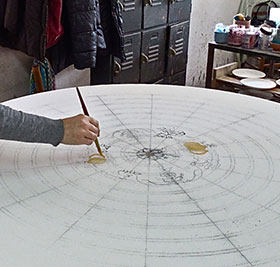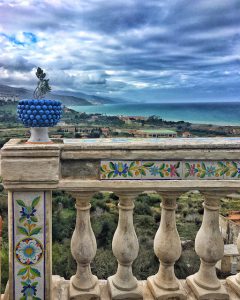Santo Stefano di Camastra
 The town of Santo Stefano di Camastra was founded in 1683 after a terrible landslide and flood destroyed the previous inland settlement of Casale di Santo Stefano. A local landlord, Giuseppe Lanza Barresi, Duke of Camastra, supervised the construction of the new Baroque urban center, located on the Tyrrhenian coast of Sicily at the base of the Nebrodi mountain range. Halfway between Messina and Palermo, it is surrounded by beautiful olive, orange, and lemon groves.
The town of Santo Stefano di Camastra was founded in 1683 after a terrible landslide and flood destroyed the previous inland settlement of Casale di Santo Stefano. A local landlord, Giuseppe Lanza Barresi, Duke of Camastra, supervised the construction of the new Baroque urban center, located on the Tyrrhenian coast of Sicily at the base of the Nebrodi mountain range. Halfway between Messina and Palermo, it is surrounded by beautiful olive, orange, and lemon groves.
 Santo Stefano’s production of pottery received a boost in the late 17th century because of the immediate need for bricks, roof tiles, and water pipes to construct the new town. Later, it continued with the production of functional, utilitarian pieces like urns, vases, and tableware. With the arrival of master ceramists from Palermo and Caltagirone and Sciacca, Santo Stefano production turned to the craftsmanship of ornately decorated tiles that were primarily used as decoration for floors and walls in the many local 18th century villas.
Santo Stefano’s production of pottery received a boost in the late 17th century because of the immediate need for bricks, roof tiles, and water pipes to construct the new town. Later, it continued with the production of functional, utilitarian pieces like urns, vases, and tableware. With the arrival of master ceramists from Palermo and Caltagirone and Sciacca, Santo Stefano production turned to the craftsmanship of ornately decorated tiles that were primarily used as decoration for floors and walls in the many local 18th century villas.
Eventually, some patterns featuring fruits and flowers and intricate geometric forms were adopted to decorate bowls, platters, and pitchers. To this day, such plaques and tiles are used. The pigne, pinecone finials are placed on top of gate pillars or balconies as a welcoming sign in many of the island’s houses. Indeed, the ceramics produced in Santo Stefanto di Camastra can be seen throughout the area.
The production of the colorful patterns that we carry, such as Sole, Fuoco, Enna, and Cerasa started relatively recently, in the early 20th century. The prominence of the bright primary colors in these more contemporary designs can be traced back to the Norman and Islamic motifs embedded in Sicilian tradition. We work with two of the most prominent, talented artisans in Santo Stefano di Camastra, Fratantoni, and La Giara.

